Health
How to Control Anxiety: Effective Techniques for Reducing Stress



The Mayo Clinic reminds us of the adverse effects anxiety can have on anyone. The excess and often sustained worry can become an obstacle to our overall happiness.
But how to control anxiety when you constantly have this niggling worry about something that might happen, leading to an irritable, restless, and worried you? Luckily, there are several ways to control anxiety. People differ, and they might not all work for you, but you will indeed find some that can help you take better control:
Deep breathing techniques
It’s easy to learn breathing exercises for anxiety. Most importantly, you can do them everywhere to help you feel more in control when anxious. Here’s how to control anxiety with several breathing exercises- try them all and choose the one that works best for you:
Extended exhale
In this exercise, inhale to the count of four, then make the exhale last longer. The aim is to make it to the count of six or longer. Do this exercise whenever you feel anxious; it helps visualize the stress flowing out with each exhalation.
Belly breathing
Here, the attention goes to your belly’s movement, helping you consciously take full, deep breaths. Breathe deeply in and out with your hand on your abdomen so that you can feel it rise and fall.
Affirmation
Whenever you feel anxious, think of a calming word or phrase. Then, inhale and exhale as you repeat it silently to create a sense of calm and focus.
Box breathing
While visualizing a box, inhale for four counts, hold for four counts, breathe out for four counts, and then hold for four counts. Box Breathing helps you maintain focus and rhythm when faced with anxious moments.
Resonant breathing
With this breathing exercise, you take five full breaths of inhale and exhale per minute, each lasting 12 seconds.
Yogic breathing
Yogic or alternate nostril breathing involves breathing in from one nostril and exhaling through the other. It takes some practice to get this technique right, but some people swear by it.
3-3-3 rule breathing technique
The 3-3-3 is a breathing exercise anyone can use in stressful situations. Inhale, hold and breathe out, each for three seconds.
Healthy lifestyle habits
Lifestyle changes may sound like a myth, but they have proven invaluable for treating anxiety, ensuring they have become integrated with its treatment approach. Here’s how to control anxiety with healthy lifestyle habits:
Start Exercising – Exercise elevates your mood, boosts self-confidence, helps you feel empowered, and enhances social connections, partly because it stimulates the body to produce the neurotransmitters serotonin and endorphins. So start with this critical lifestyle change by finding the exercise routine that suits you, whether walking, yoga, aerobics, swimming, etc.
Diet – A healthy diet helps send a steady flow of vital nutrients to the brain to produce neurotransmitters. Therefore, cut out sugar and trans fats. Instead, get more fresh foods, whole foods, and water. Also, keep your calcium intake high. Look after your gut health since it’s connected with brain health. Eat fermented foods like yogurt, miso, kimchi, tempeh, etc., for their probiotics. Also, cut out or cut down on caffeine because studies have linked it to anxiety.
Alcohol – Stop drinking alcohol because it is a depressant. Even though you may think it numbs your anxiety, it’s not.
Sleep – Sleep helps the body replenish neurotransmitters. You will feel more anxious if you aren’t getting enough. Up your sleep by establishing a bedtime routine and practicing sleep hygiene.
Don’t smoke – Like alcohol, smoking increases anxiety.
Positive thinking – When you live with anxiety, you tend to have feelings of hopelessness, helplessness, and negative attitudes. These affect the immune system and the production of those essential brain chemicals. You can do many things to train your brain to change its perceptions, including meditation. Researchers say that kindness, gratitude, and forgiveness can also help, but you need practice to develop these skills.
Reduce Stress – Stress aggravates anxiety, so learn how to minimize it. Start by identifying your stressors and finding ways to reduce their presence. Practice relaxation techniques to reduce its effects and cultivate resilience to handle the stress you cannot avoid.
Social Support – Anxiety might make you want to avoid others, but social support is critical to dealing with it. Don’t let yourself feel isolated. Maintain regular contact with friends and family, take up a hobby or class to meet others, volunteer, or get a pet.
Purpose and Spirituality– Research shows that having a purpose makes people more resilient to challenges and stress. A solid spiritual viewpoint does the same.
Read more about the healthy lifestyle factors research shows are most important for reducing depression and anxiety from Medical News Today.
Cognitive behavioral therapy
The psychological treatment known as cognitive behavioral therapy (CBT) aims to help you recognize and change the damaging thought patterns that have a negative influence on you. It uses cognitive therapy with behavior therapy to help you change the negative thought process that contributes to your anxiety. It helps people with anxiety and depression to learn to trade negative thoughts with realistic ones.
CBT uses several techniques and approaches to help your thoughts, emotions, and behaviors. Here are some methods you can expect:
- Identifying the negative thoughts that lead to your anxiety.
- Learning new ways to cope to help you avoid or deal with anxiety-inducing thoughts or situations.
- Setting goals to help you make changes to your negative thoughts.
- Learning to solve problems that arise from life stressors. Expect these five steps in problem-solving in CBT:
- Identify the problem
- Create a list of potential solutions
- Evaluate each potential solution’s strengths and weaknesses
- Choose which one to implement
- Implementation
- Self-monitoring is vital in CBT because it helps you track and share your experience with your therapist. You keep a diary with all your emotions, thoughts, and experiences relating to your anxiety to help your therapist determine the best treatment.
- Additional CBT techniques on how to control anxiety may include journaling, practicing relaxation strategies, role-playing, and doing mental distraction exercises.
Natural remedies for anxiety
Research on herbal remedies shows that they may help with anxiety, but studies on their risks and benefits are ongoing.
Here are some of the most popular natural remedies:
Passionflower
Some clinical trials suggest that passionflower might help. Some supplements combine passionflower with other herbs, making it difficult to understand the properties of each herb. However, its short-term use may help with alleviating anxiety and restlessness.
Valerian
Valerian has been used for centuries to treat anxiety, depression, and sleep issues. Studies have failed to show its effectiveness, but it’s worth trying because it’s generally safe to use except for young children and nursing or pregnant people.
Chamomile
Camomile tea and supplements are generally safe to use, except for people with an allergy to it or for people taking warfarin to thin the blood or cyclosporine ( the anti-rejection drug).
Lavender
Taking a lavender supplement or using it as aromatherapy seems to reduce anxiety, according to some research. However, because it can disrupt hormones, it’s not recommended for teens. Those who are pregnant or breastfeeding should also avoid taking it orally.
Lemon balm
Some studies show that lemon balm can lessen some symptoms of anxiety. It’s a well-tolerated natural remedy for short-term use. Whether lemon balm is safe during pregnancy or when breastfeeding is still to be established.
Other natural remedies that show promising results include the adaptogen ashwagandha, galphimia glauca, kava kava, and cannabidiol.
However, remember that even though these are natural remedies, they are not always safe. Quality controls exist, but drug associations globally don’t monitor them like other medications. Additionally, get advice from a healthcare professional before taking any of these natural remedies because they can interact with other medicines.
Creating a support network
Mental health professionals stress the importance of creating a strong support network when considering how to control anxiety. A support network includes friends, family, colleagues, and support groups. It can also include social activities and your religious community.
These play various roles, providing emotional, instrumental, and informational support. For example, a colleague might take on a praising, guiding, or mentoring role, whereas a partner or spouse can provide a shoulder to cry on, take care of your physical needs, and give you advice.
Creating a support network is vital in helping you with how to control anxiety. Here’s how:
- Provides a sense of belonging
- Reduce anxiety and stress
- Improves your overall physical and mental health through emotional support
- Increases your self-esteem when you know you have someone who relies on you, or you can rely on
Managing stress effectively
According to WebMD, here’s how to control anxiety by managing stress effectively:
- Maintain a positive attitude.
- Accept that you cannot control everything.
- Don’t become aggressive; learn to be assertive.
- Learn effective time management.
- Learn to say no and to set limits.
- Make time for yourself by having hobbies and interests.
- Drugs and alcohol can stress you further and make you more anxious, so stop relying on them.
- Spend enough time with people whose company you enjoy because social support is vital.
- Therapy teaches you healthy ways to deal with stress, meaning it’s an important option.
Developing relaxation techniques
We all face stressful situations, from minor annoyances to severe worries. It takes practice to learn relaxation techniques, but once you master them, you can take control of your anxiety. Remember, they don’t all work for everyone. So, find the best one for how to control anxiety for you:
- Focus on breathing using any of the exercises mentioned in section 1.
- Perform a body scan while using progressive muscle relaxation, focusing on one part of the muscle groups at a time.
- Use guided imagery by thinking of soothing experiences or places to help you relax and focus.
- Practice mindfulness meditation to bring your mind to the present moment.
- Take up yoga, tai chi, and qigong for their postures, flowing movements, and rhythmic breathing. These are excellent for flexibility, balance, and calming racing thoughts.
Other relaxation techniques include massage, meditation, prayer, aromatherapy, hydrotherapy, and autogenic therapy.
Seeking professional help
Some situations make it essential to seek professional help to help you learn how to control anxiety. Here’s how to know when you should see a professional:
Your anxiety becomes an obstacle in any aspect of everyday living, often causing difficulties for six or more months.
- Your anxiety affects your relationships
- You feel isolated, hopeless, or helpless
- You have constant excess worry that affects you emotionally and physically
Depending on the severity of your anxiety, you can seek support from various people. These could be a family member, a friend, someone from your community, a support network, a therapist, or a medical professional. It’s essential to recognize your anxiety and to share your concerns because you can get the help required to identify it and address it.
Getting help may include a behavioral therapy plan, anti-anxiety medication, and learning coping mechanisms, depending on its severity. The aim is to move past the excessive worry that has taken control of your life by learning the skills to erase negative thoughts.
When to Seek Professional Help for Anxiety
Knowing when to reach out for professional assistance can be crucial for managing anxiety effectively. Consider professional help if:
- Persistent Anxiety: You experience anxiety that is persistent and interferes significantly with your daily life, including work, relationships, or personal happiness.
- Physical Symptoms: Constant physical symptoms like palpitations, dizziness, or chest pain are present, and anxiety seems to be a contributing factor.
- Ineffective Self-Help Measures: Common self-help techniques and lifestyle changes have not adequately addressed your symptoms.
- Substance Use: You find yourself increasingly relying on substances like alcohol or drugs to cope with your anxiety.
Choosing Between Medication and Therapy
The decision between medication and therapy depends on various factors, including the severity of your anxiety, your personal preferences, and past responses to treatments:
- Medication Can effectively reduce symptoms quickly and is often used in severe cases. However, medications can have side effects and typically do not address the underlying causes of anxiety.
- Therapy: Particularly cognitive behavioral therapy (CBT), helps you understand and change the thought patterns that contribute to anxiety, offering long-term benefits without the side effects of medication.
Setting Goals to Manage Anxiety
Setting clear, actionable goals is a powerful way to manage anxiety. When setting goals, consider:
- Specificity: Make your goals specific and actionable, such as “practice breathing techniques for 10 minutes every morning.”
- Measurable: Ensure that you can track your progress. For example, use a journal to note the frequency and intensity of anxiety episodes.
- Achievable: Set goals that are realistic and attainable to avoid additional stress.
- Relevant: Choose goals that are directly related to managing your anxiety and improving your quality of life.
- Time-bound: Give yourself a clear timeline for achieving your goals to maintain motivation.
Recognizing Progress in Anxiety Management
Monitoring your progress is essential for staying motivated and adjusting your management strategies. To effectively recognize progress:
- Track Changes: Make a record of how frequently you experience symptoms of anxiety and note any changes in their intensity or frequency.
- Celebrate Small Wins: Acknowledge and celebrate small achievements along your journey. This can be as simple as recognizing a week you felt less anxious than usual.
- Seek Feedback: Regular check-ins with a mental health professional can provide professional insights into your progress and help adjust your strategies if needed.
By incorporating these sections into your blog, readers will gain valuable guidance on when to seek help, choose between medication and therapy, set realistic goals, and recognize progress in managing anxiety. This structured approach can empower readers to take active steps toward improving their mental health.
—
This post was previously published on RESTEQUATION.COM.
***
From The Good Men Project on Medium
Join The Good Men Project as a Premium Member today.
All Premium Members get to view The Good Men Project with NO ADS.
A $50 annual membership gives you an all access pass. You can be a part of every call, group, class and community.
A $25 annual membership gives you access to one class, one Social Interest group and our online communities.
A $12 annual membership gives you access to our Friday calls with the publisher, our online community.
Register New Account
Need more info? A complete list of benefits is here.
—
Photo credit: iStock
Health
Brooks Ghost Max Running Shoes Are Nearly $50 Off Right Now

Men’s Journal aims to feature only the best products and services. If you buy something via one of our links, we may earn a commission.
Dick’s Sporting Goods is in the midst of a major sale on running shoes from brands like Hoka, On, and Nike, with Brooks accounting for some of the retailer’s most appealing discounts. Styles like the Glycerin StealthFit and the Adrenaline GTS are on sale, but the one turning heads right now is the high-stack and ultra-cushioned Ghost Max—and it’s selling fast.
Right now,
Brooks Ghost Max Running Shoes in Black/Ebony, $102 (was $150) at Dick’s Sporting Goods
The Ghost Max takes all the best features of the traditional Ghost running shoe, like great breathability and ample under-foot support, and adds a super high-stack cushion that amplifies protection and shock absorption from surface textures. This is a huge upgrade for those with sensitive feet, as it decreases the pressure exerted on the foot, and the larger cushion also provides a wider base, which helps with stability. And, though this sneaker has a more level 6 mm heel-to-toe differential (half that of the normal Ghost), it uses a rocker bottom to help achieve a smooth, comfortable stride when walking.
The maximum cushion is an immediate standout for anyone who steps into these Brooks running shoes, especially those who have to stand a lot. “I’m not a runner, but stand on concrete all day,” a shopper began. “They are, by far, the most cushioned and comfortable shoes I’ve ever worn. I’ve tried Hoka, Asics, and Oofos, but the Ghost Max is my favorite. If you need cushion in your step, look no further.” Another shopper agreed, simply saying they were “super comfortable shoes” with “lots of support.”
Brooks Ghost Max Running Shoes in Cream, $102 (was $150) at Dick’s Sporting Goods
In some cases, shoppers are even switching from their Ghosts—the brand’s most popular sneaker—in favor of this model. “I have been a Brooks Ghost user for many years,” a shopper said. “Love the Ghost Max. Superior cushioning is the key. Being a larger runner of over 30 years (6-foot-3, 240 pounds) the extra cushioning is very much appreciated. The shoes fit perfectly and the ride is smooth. My knees, ankles, and thighs thank you!”
Whether you’re looking for the perfect walking shoe or some extra protection from a daily runner, it’s well worth trying the
Prices are accurate and items in stock at time of publishing.
Health
Bridging Generational Divides in Medical Education: Gen Z Med Students’ POV



By Nichole Sanchez Diaz, Sanja Kostov, Erin Bearss, Milena Forte
What comes to mind when you think of “Gen Z” (1996-2010)?
Anecdotally, it seems preceding generations (Boomers, Gen X, Millennials) have seen us as “digitally savvy yet too sensitive.” And while we cannot generalize an entire cohort, there’s truth that this is generating friction in medical education.
Raised in the digital age, Gen Z faces higher rates of mental health issues than its predecessors. This cohort also has a stronger desire to uphold principles of equity, diversity and inclusion (EDI) that can sometimes challenge traditional medical teachings, thus creating novel tensions between medical trainees and their educators.
Medical training is notoriously challenging, with responsibility and stress levels increasing with each passing year. It compares to the stress of starting a new job every few months while being the least informed contestant in a never-ending Jeopardy episode. When you add in the sleep deprivation that comes from working around the clock, it’s not surprising that training can negatively impact the mental health of medical learners. A 2018 Canadian Medical Association survey revealed alarming rates of burnout and depression among resident physicians; more recent studies point to this being an even bigger issue since the pandemic. Given that circumstances have made Gen Z appear to be even more psychologically vulnerable than previous generations, what measures have been implemented to ensure their collective success and are these measures sufficient?
In recent years, institutions have rolled out wellness programs and mental health services. These are steps in the right direction, but are often inaccessible to trainees , especially during residency. The unwritten expectation of self-sufficiency discourages trainees from openly discussing their mental health needs with educators, fearing they may be perceived as fragile or, worse, incompetent.
Recent studies reflect what Gen Z residents value in wellness strategies: clear communication and community building, particularly with their educators. Despite their digital upbringing, they crave in-person teaching and opportunities to develop deeper connections with their mentors.
Educators can play a pivotal role in dismantling the stigma surrounding mental health during medical training. By sharing their personal experiences and coping mechanisms, and promoting wellness resources, they can normalize discussions around mental health and burnout; topics with which many trainees struggle but are afraid to vocalize. An honest dialogue between mentor and mentee is a powerful tool for building mutual trust and can increase the chances of identifying and addressing mental health challenges before they escalate.
As an ethnically and socially diverse cohort, Gen Zs recognizes EDI as more than a buzzword.
Gen Z medical learners can also take steps, such as understanding their program’s purpose and expectations, establishing clear expectations with their educators, and identifying existing resources in advance. If they encounter challenges, they should investigate and access formal supports offered by their programs (e.g., accommodations or extensions to training) to avoid sacrificing their well-being.
As an ethnically and socially diverse cohort, Gen Zs recognizes EDI as more than a buzzword; it is an expectation of their future workplace. Their openness to embrace new perspectives combined with unparalleled access to information online makes them more likely to challenge long-standing practices.
For example, a preceptor commenting on the risks of high BMI can provoke discomfort in a student who believes it perpetuates fat-phobic attitudes, influenced by social media discussions about patient discomfort with weighing at medical visits. The emphasis on political correctness has made some physicians cautious when teaching, fearing a backlash. To remedy this, educators can practice listening to and understanding student perspectives, especially those discordant with their own. Using this as a teaching opportunity, faculty members can discuss evidence supporting their clinical practice and share personal experiences while simultaneously addressing gaps in their knowledge and updating outdated terminology.
Learners should feel empowered to challenge established medical practices, but they need to be cautious about forming their beliefs based on virtual discourse that can spread misinformation, particularly when they have limited clinical experience. Clinical educators can often contextualize and tailor available evidence to specific patient situations based on their medical expertise and a host of varied patient experiences. Embracing opportunities for humility and shared learning enables a safe learning environment that encourages curiosity and ensures training is rooted in evidence-based practice. While these are difficult conversations, they are vital because dismissing learner concerns only leads to mistrust.
Adapting medical education for Gen Z learners isn’t about coddling – it’s about evolution. This is a call for educators to acknowledge generational differences and be willing to gradually shift the hustle culture of medical training to foster a more supportive learning environment through respectful dialogue.
Gen Z respects authority but will learn best under mentors who encourage transparent discussions around mental health and social accountability in medicine. For students to fully benefit from their education, they must also clearly understand the expectations of their roles. By embracing innovation while upholding core values in medical education, we can shape students into resilient professionals who can thrive in today’s demanding health-care landscape.
—
Previously Published on healthydebate.ca with Creative Commons License
***
You Might Also Like These From The Good Men Project
All Premium Members get to view The Good Men Project with NO ADS. A $50 annual membership gives you an all access pass. You can be a part of every call, group, class and community. A $25 annual membership gives you access to one class, one Social Interest group and our online communities. A $12 annual membership gives you access to our Friday calls with the publisher, our online community. Need more info? A complete list of benefits is here.
—
Photo credit: iStock
Health
15 Best Gay Sex Positions for Couples to Explore

When it comes to gay sex positions, pleasure isn’t one-size-fits-all. Men looking for fun and different sex positions should play around with unique missionary sex positions, 69 sex position variations, and even Amazon sex position to add excitement and novelty. Experimenting with lubes and sex toys for men (think prostate massagers, anal beads, and cock rings) will only enhance the best gay sex positions, so come to the bedroom with an open mind.
Like any sexual experience, gay sex is personal and there’s a lot of experimentation that can be done to understand your preferences and the preferences of your partner.
“Some men don’t understand what exactly turns them on,” says Finn Deerhart, AASECT-certified sexuality counselor, who works primarily with queer men. “They assume their turn-on is a causal result of the objects they desire or a set of conditions. However, when it comes to sexual arousal, and the deeply personal nature of that energy, it’s less about the specific objects and more about the implied sense of meaning a man derives from his sexual experiences.”
Below, Deerhart, alongside multiple sex experts, share a guide to the best gay sex positions for men that will offer inspiration to try something new, lean into what you like most, and connect with your mind-body connection to be a better lover.
1. Doggy Style
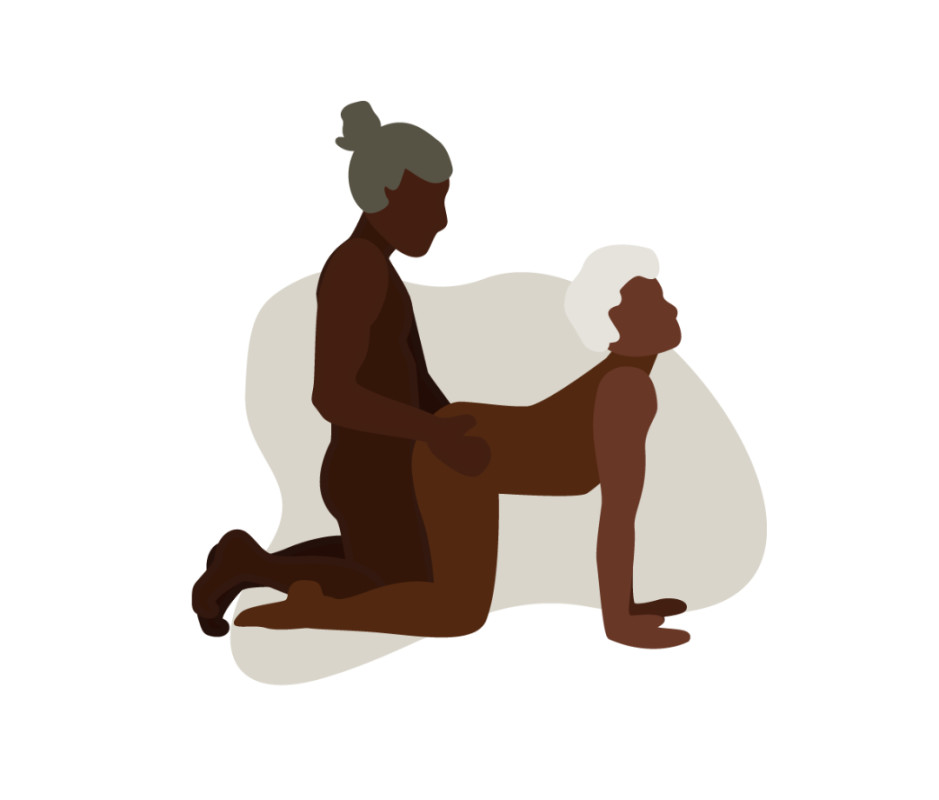
Katie Buckleitner
How to Do It
“This one is a staple for many gay men,” says Deerhart. The receiver kneels or stands facing away from the penetrator. With hips raised, the receiver takes the penetrator as deeply as they desire.
Why It Works
“The absence of eye contact is part of why men love doggy style,” says Deerhart. “They’re able to tap into their animal bodies while enjoying a degree of emotional opacity.” Removing direct eye contact can help lower inhibitions and encourage partners to be more present in the moment.
| Pros | Cons |
|---|---|
|
Deeper penetration |
Can be too deep for the receiver, depending on capacity and depth |
|
Freedom of movement for the one thrusting |
|
|
Receiving partner can masturbate, if desired |
|
|
Lack of eye contact lowers inhibitions |
Pro Tip
Go slowly and use plenty of lube. We recommend Boy Butter. It’s a fan favorite among users because it’s long-lasting, easy to clean, and strikes a balance between the stickiness of water-based lubes and the greasiness of silicone. Its consistency starts like a lotion that melts into an oil as you work it between your hands. Just note this is not condom-compatible!
2. Spooning
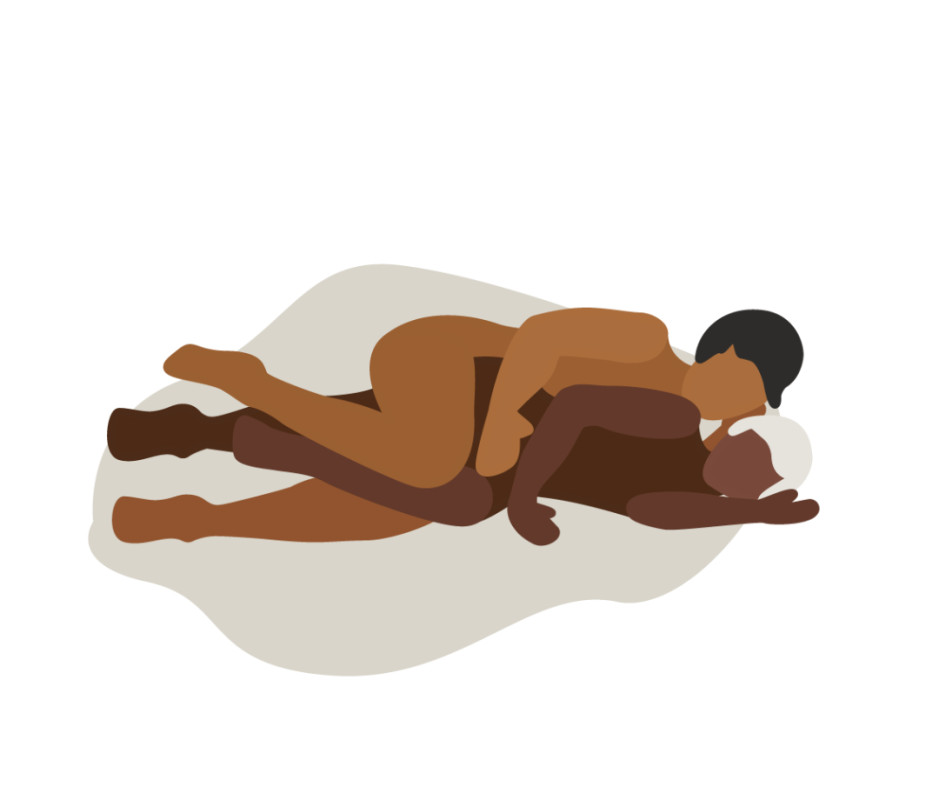
Katie Buckleitner
How to Do It
The receiving partner lies on their side with their back toward their partner, while the penetrative partner applies lube and aligns their pelvis to the receiving partner’s butt to assume the “spooning” position. The receiving partner can arch their low back and extend their bottom leg long while bending the top one closer to their chest to create more space for the giver to rest their top leg over them and enter. “Because half of the body is being restricted by the bed, it can be difficult to make adjustments once started,” explains Dr. Rossana Sida, a licensed marriage and family therapist and AASECT-certified sex therapist in Los Angeles, CA.
Why It Works
“This is the best on a lazy morning where relaxation and intimacy are key,” says Sida. It doesn’t require acrobatics, plus the receiving partner can touch their partner or themselves, either masturbating or giving attention to erogenous zones to enhance arousal.
| Pros | Cons |
|---|---|
|
Heightened intimacy between partners |
Difficult to find the right angle |
|
Low-energy position, perfect for morning sex |
Hard to get the leverage to thrust in and out |
|
Lots of skin-to-skin contact |
Pro Tip
The receiving partner can place a small sex wedge or pillow, like Foam Heart Sex Pillow, between their knees if both are tucked to maintain space and limit fatigue.
3. Missionary
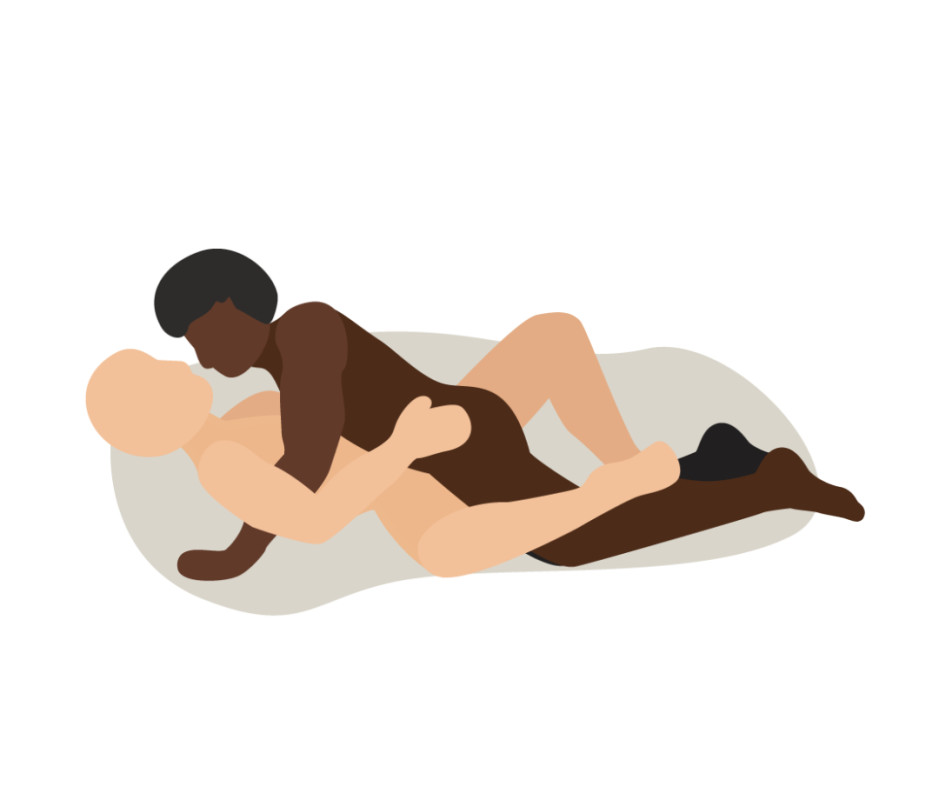
Katie Buckleitner
How to Do It
The receiving partner lies on their back with legs butterflied open, while the giver lies on top and supports their body weight with their arms. The penetrative partner enters so they’re face-to-face. To modify this, the receiving partner can place their legs over the giver’s shoulders for more direct prostate stimulation.
Why It Works
Missionary is a classic position that offers a high degree of emotional connection due to the direct eye contact, says Deerhart. You get feedback in real time and can read each other’s facial expressions.
| Pros | Cons |
|---|---|
|
Promotes a heightened sense of connection due to eye contact |
Can be overwhelming sometimes for men who would prefer to be less emotionally seen |
|
Can read facial expressions for real-time feedback |
Can be physically demanding for the penetrator who has to hold their upper body—or the receiver’s legs—up |
|
Provides direct angle for prostate stimulation |
Pro Tip
Use a sex wedge to elevate the bottom partner’s hips. We like Liberator Wedge Intimate Sex Positioning Pillow. The 27-degree angle is the ideal pitch for deeper penetration and stimulation.
4. Standing (Bodyguard)
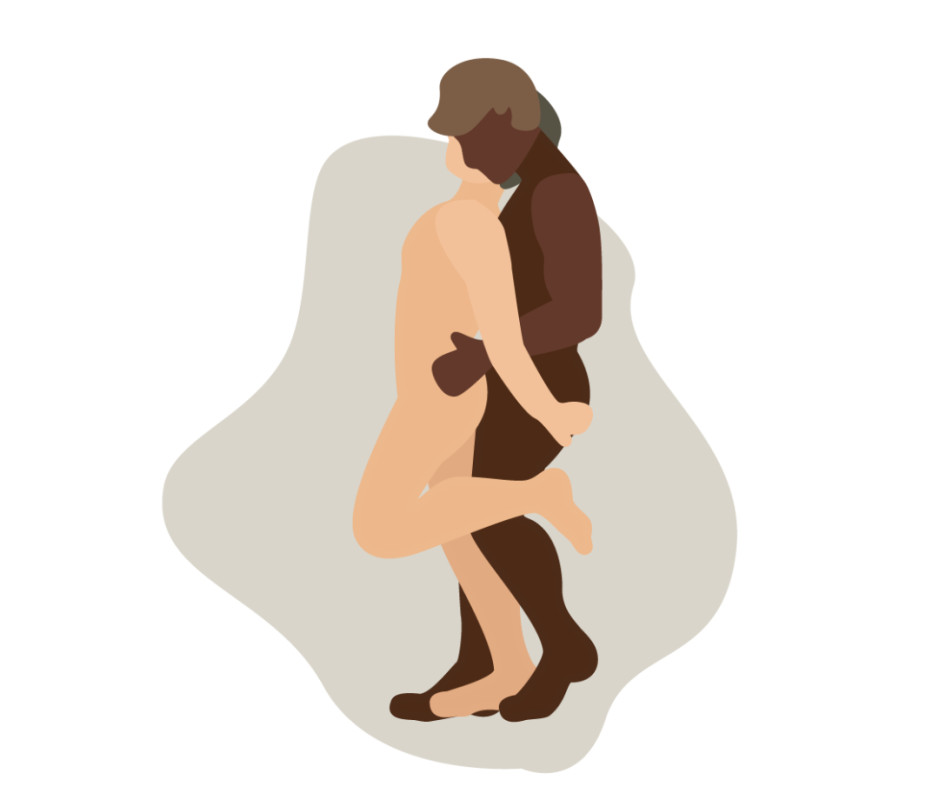
Katie Buckleitner
How to Do It
The receiving partner stands with knees slightly bent for stability, facing away from their partner. They can stand in front of a wall and support their body weight with their hands or stand before a bed and brace their weight by kneeling one leg on it (shown). If kneeling one leg, the receiving partner can lean forward slightly and reach behind and grab their partner’s hips or thighs for greater balance. “While adequately lubricated, the penetrative partner will insert their penis, being mindful of their partner’s comfort,” says Sida. The giver should tilt their pelvis up and choose between a more sensual or vigorous rhythm of movement. Whichever feels best, both partners will need to move their hips in sync with each thrust.
Why It Works
This is an easy anal sex position to bring role play into your repertoire. Also known as “bodyguard” position due to the restraining nature of the position, you and your partner can play with domination. Moreover, the receiver can additionally masturbate while receiving anal if standing in front of a wall for balance.
| Pros | Cons |
|---|---|
|
Allows for spontaneity as standing means you can have sex in the kitchen, home office, or shower |
Both partners need to have good balance |
|
May be too physically demanding for an entire sexual experience, but it can start things off |
Pro Tip
Have the penetrative partner insert a vibrating butt plug like Lovehoney Butt Tingler 10 Function Vibrating Butt Plug. It’s great for intermediate users what with its four-inch length and flared base. The bulb houses a removable bullet vibrator that has three vibration speeds and seven patterns to find the right sensation.
5. Rusty Trombone
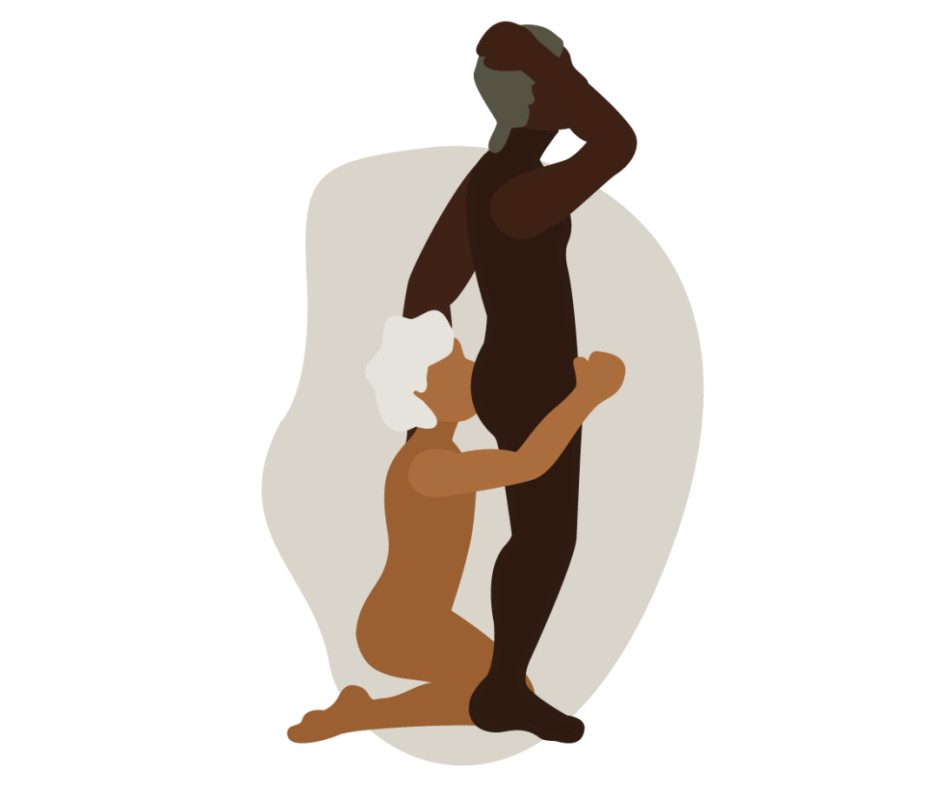
Katie Buckleitner
How to Do It
The receiving partner stands with legs slightly apart, while the giving partner kneels behind them, performing analingus (aka rimming) while simultaneously providing a hand job. The position vaguely resembles playing a trombone. For the giver, it requires plenty of coordination between the hand and mouth.
Why It Works
This is a multifaceted experience for the receiver, as it combines oral and manual stimulation for intense pleasure, says Bedbible.com sex educator Kasia Halinowska.
| Pros | Cons |
|---|---|
|
Provides dual stimulation as a rim job and hand job |
Requires flexibility and balance |
|
Difficulty to master coordination for giver |
Pro Tip
Get in the shower together beforehand and get really clean. This will put both of you at ease if you’re starting with optimal hygiene. Our favorite unscented body wash is Nécessaire Fragrance-Free The Body Wash.
6. Legs Up
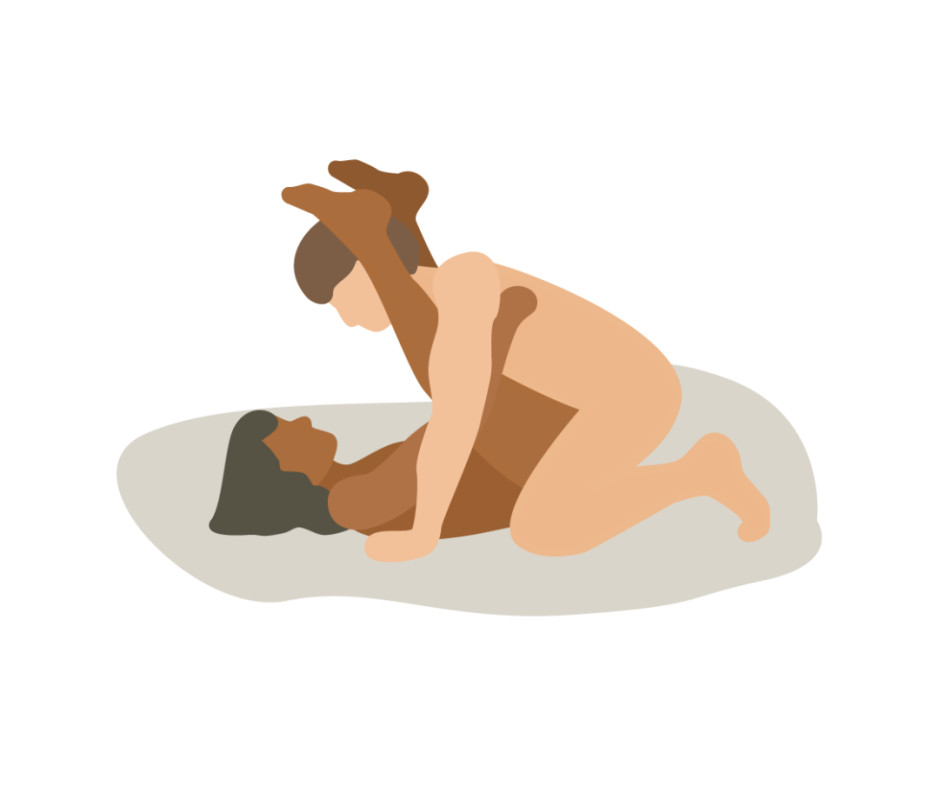
Katie Buckleitner
How to Do It
The receiving partner lies on their back with legs up so the penetrative partner can kneel, place their hands on either side of them, and slowly ease in. The receiving partner can lift their hips and rest their calves against the penetrative partner’s shoulders, which allows for deeper penetration, as well as greater support.
Why It Works
The receiving partner won’t get fatigued having to hold their legs up on their own, and this face-to-face positioning helps “maintain eye contact for intimacy,” says Halinowska.
| Pros | Cons |
|---|---|
|
Promotes deep connection with face-to-face contact |
Might not allow for very deep penetration |
Pro Tip
Try a hybrid lube that comprises water and silicone, like Hello Cake Tush Cush, for greater comfort and longevity. It won’t dry out as quickly as other lubes and helps prevent tearing.
7. Back It In
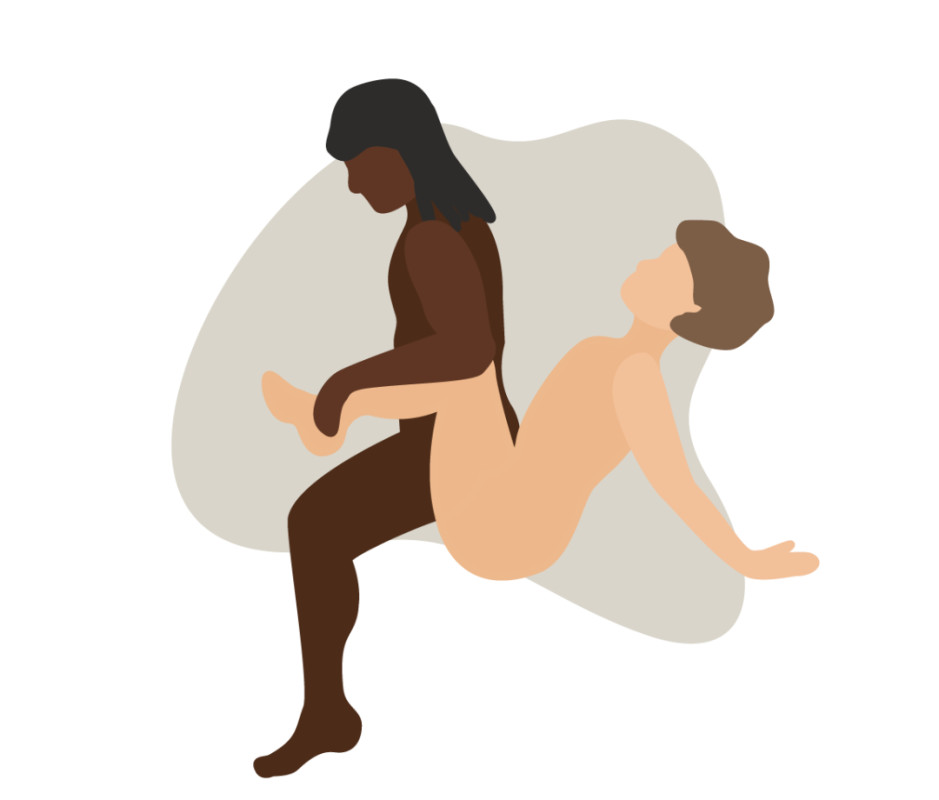
Katie Buckleitner
How to Do It
The giving partner sits in a chair with knees to chest, torso angled back in a reclined position. Use pillows to provide the proper support and get the angle right. The receiving partner backs into the position and lowers onto their partner’s penis. The receiving partner should use their legs to lower up and down.
Why It’s Great
This is a position for those chasing novelty—who want a change of pace, says Halinowska.
| Pros | Cons |
|---|---|
|
allows for control over depth of penetration |
can be a bit awkward to get into position initially |
|
difficult for giving partner to keep legs elevated without support |
|
8. Helicopter
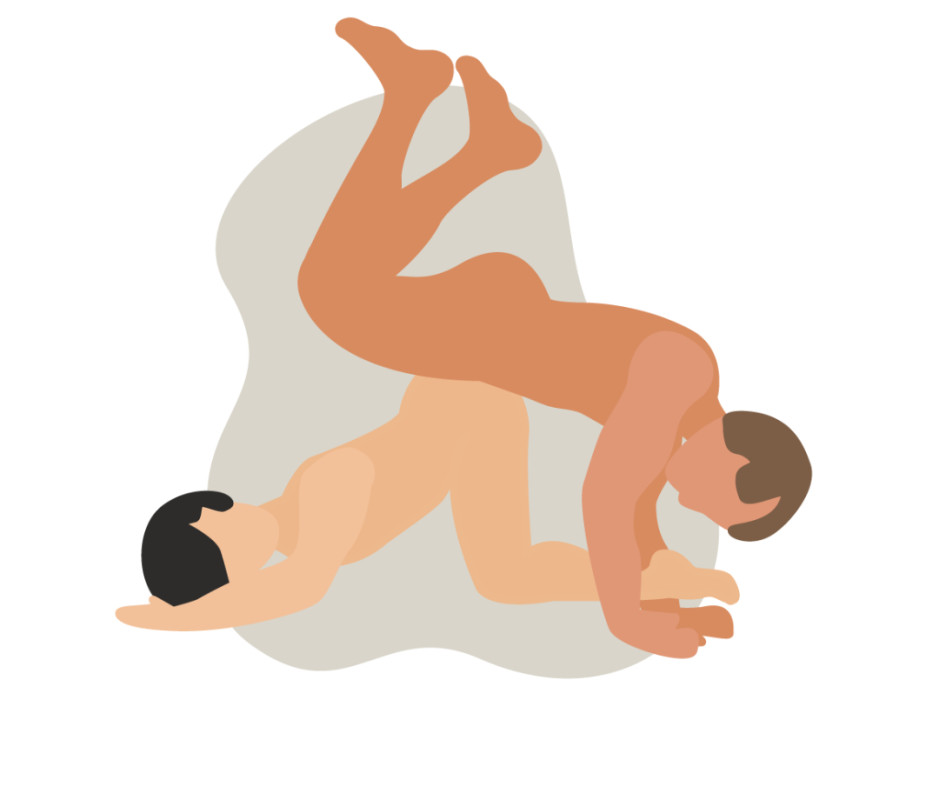
Katie Buckleitner
How to Do It
The receiving partner gets on hands and knees, then lowers down to their forearms, to start. The penetrative partner does a down dog over them, head positioned by the receiving partner’s feet, and aligns their pelvis with the receiving partner’s anus. The giver penetrates their partner as they lift their legs to create a helicopter shape. The penetrative partner will keep their pelvis on the receiving partner’s butt, using their arms to support their body (think pushup position), explains Halinowska.
Why It’s Great
You won’t get deep penetration, but due to the downward angle of the penetrative partner’s penis, it stimulates the head. Helicopter is fun and challenging, bringing a bit of spontaneity to your sex life if things have felt ho-hum
| Pros | Cons |
|---|---|
|
adds novelty to sex |
penetrating partner must have a strong upper body to maintain |
|
provides unique entry and stimulates the head of the penis |
difficult to maintain balance and find rhythm |
9. Cliff Diver
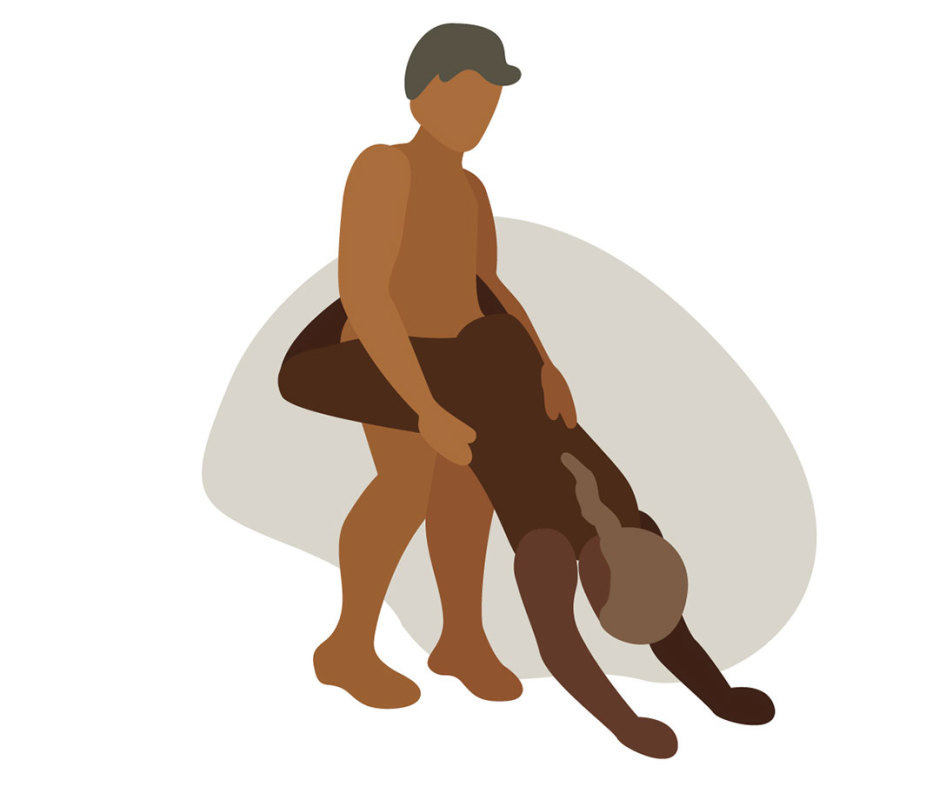
Katie Buckleitner
How It Works
The receiving partner gets on all fours while the giving partner helps lifts their legs off the ground, one at a time, wrapping them around their waist for more control and support. The penetrative partner then inserts their penis and holds onto the receiving partner’s hips.
Why It’s Great
It’s a little more advanced, but for those looking to experiment with standing sex positions, this can create a strong prostate orgasm.
| Pros | Cons |
|---|---|
|
Exciting and adventurous for couples |
Requires strength and coordination |
|
Provides intense stimulation |
Not suitable for all fitness levels |
|
Can be scaled to a chair to limit the load on the receiving partner’s arms |
10. Pirates Booty
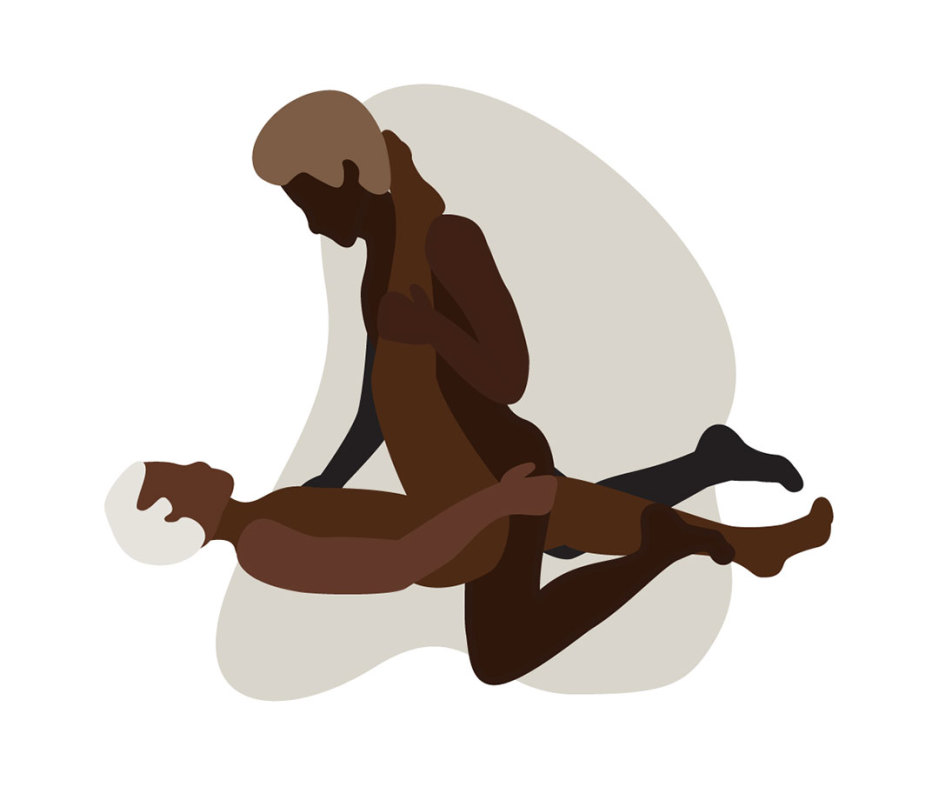
Katie Buckleitner
How to Do It
“This is a twist on missionary position that allows for deeper penetration,” prefaces Searah Deysach, sex educator and owner of Early to Bed. The receiving partner lies on their back with one leg down and the other leg in the air. The penetrative partner straddles the planted leg, slides in, then rests the receiving partner’s extended leg on their shoulder. “This allows the giver easy access and a great view,” says Deysach.
Why It Works
Pirate’s booty is for couples looking for a missionary sex position variation that’s outside the norm. It allows for deep penetration.
| Pros | Cons |
|---|---|
|
Both parties can kiss and cuddle while in this position |
Receiver needs to have good hip flexibility |
|
Receiver can stimulate his penis easily (and the giver can help if they don’t need both arms to balance) |
Lifting just one leg can cause the pelvis to tilt, which might make the penetrator hit the side of the pelvic bone |
|
Communication is easier when looking at each other |
Pro Tip
Lifting just one leg can cause the pelvis to tilt, which might make the top hit the side of the pelvic bone. To avoid this, you might have to lift both legs to keep the pelvis level.
11. London Bridge
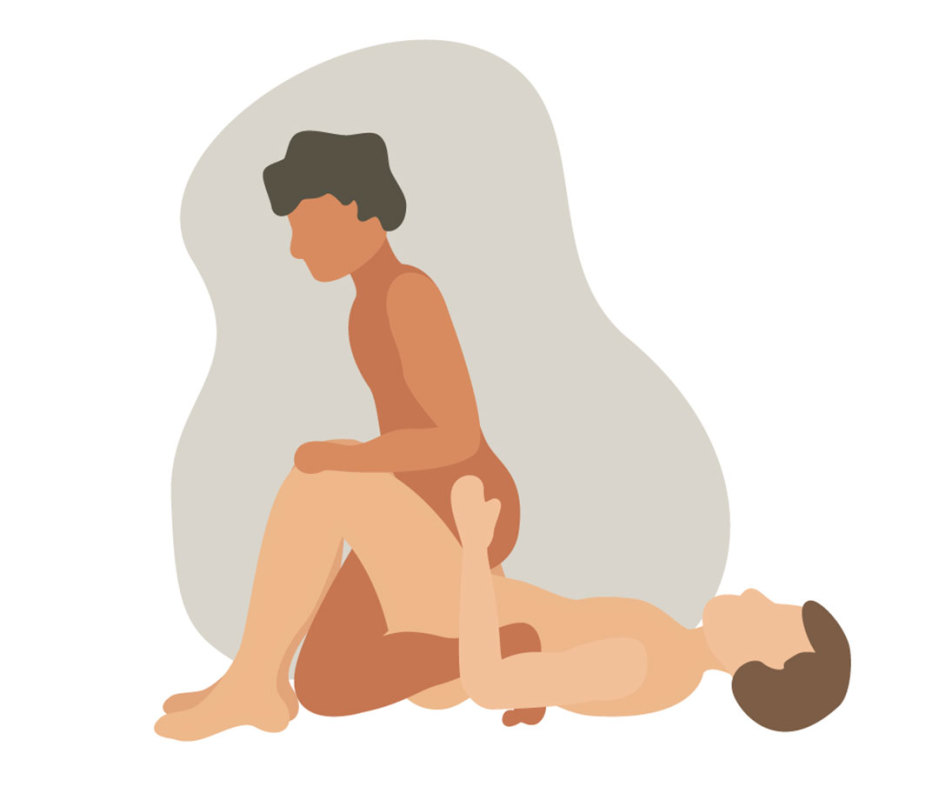
Katie Buckleitner
How to Do It
The penetrative partner lies on their back, feet flat, knees bent. The receiving partner backs on top of the penetrative partner, between their legs, easing onto their partner’s penis while facing away. “It’s a reverse insertion position,” says sex educator, Goody Howard. “The rider can grind down, lift their hips, dance, squeeze their sphincter muscles for mutual pleasure, and put their hands on their partner’s knees for stability and leverage,” says Howard. “For even more leverage, the rider can “lower the bridge” even further and put their elbows on the bed (or floor).”
Why It Works
This position is actually the great equalizer for couples who may have larger height and weight differences. It also perfectly aligns the penis and anus and is less taxing than other non-traditional positions.
| Pros | Cons |
|---|---|
|
Low impact on the knees and back |
Rider needs to be careful when leaning down. It’s important to finesse and smoothly transition from upright to leaning on elbows |
|
Great for genital alignment, so big height differences don’t matter as much |
|
|
Good for plus-size couples |
|
|
Increases sensitivity for the person being ridden |
Pro Tip
To ensure you don’t have to stop before the climax to add more lube, try Lelo F1L. The long-lasting, water-based lubricant is hypoallergenic and unscented.
12. 69
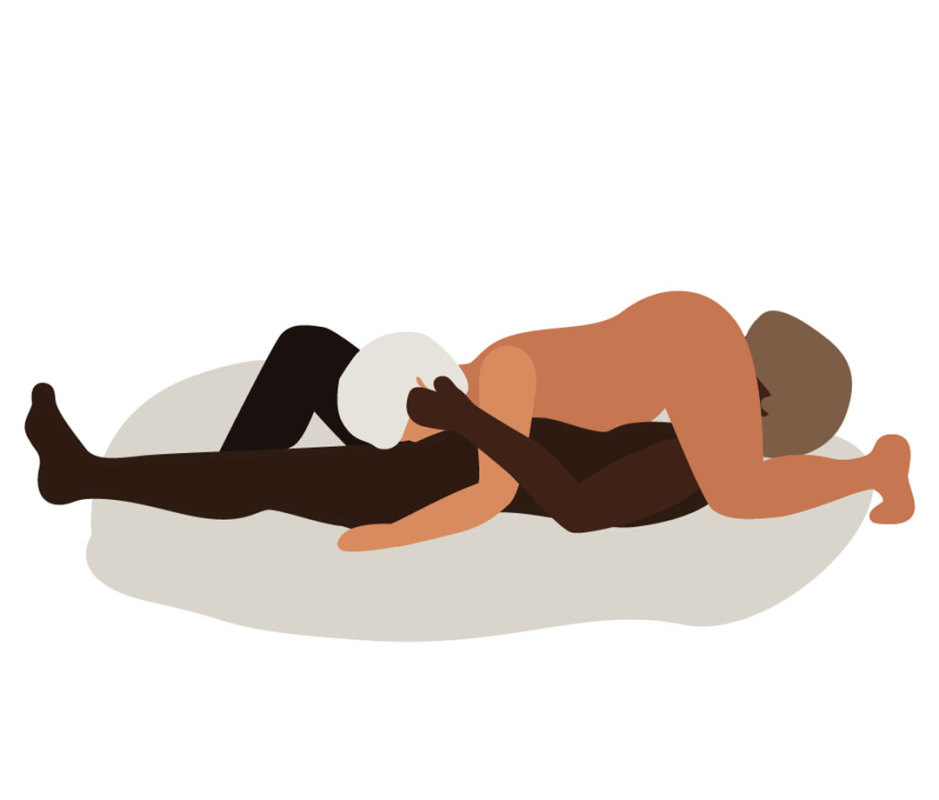
Katie Buckleitner
How to Do It
Both partners lie in opposite directions: one partner’s head on the other’s cock and vice versa, sucking each other at the same time. “This position is great for Sides, men who love sex with men but don’t enjoy anal sex,” says Deerhart. “The 69 sex position makes it possible for each to relax into mutual receptivity since both are receiving oral at the same time.”
Why It Works
“The magic of 69 is it releases each man from any pre-existing, prescribed roles and allows each to stay focused on the pleasure of giving and receiving without a fixed context,” adds Deerhart. Plus, the partner on bottom can give a rim job or a blow job.
| Pros | Cons |
|---|---|
|
Heightens the odds of mutual orgasm |
Some partners can get overwhelmed and lose the ability to stay focused on their own pleasure |
|
No set “roles” for partners |
Related: The Best Nipple Clamps of 2024 for Maximum Pleasure
13. Lotus
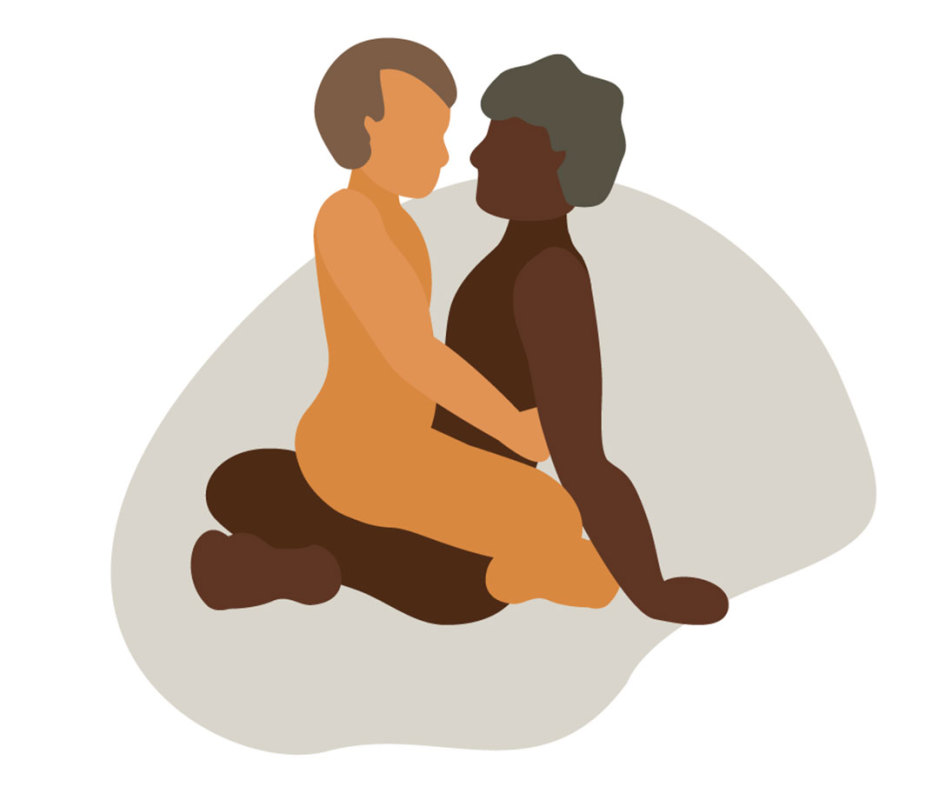
Katie Buckleitner
How to Do It
Lotus is a tantric sex position. To get into it, the bottom (penetrative) partner sits cross-legged, torso upright, then the receiving partner straddles them so they’re face-to-face. The top partner can also cross their ankles or have feet touch, says Halinowska, and both partners can wrap their arms around each other. This is more of a rocking position, with the top partner controlling the speed and rhythm. To help counterbalance, the bottom partner can lean their hands back for greater support and leverage.
Why It Works
Lotus is an incredibly intimate position, as it encourages and maintains eye contact between partners.
| Pros | Cons |
|---|---|
|
Promotes full-body, sensual contact, and deep connection |
Might not be ideal for extended periods due to the seated position’s strain on hip flexors |
|
Hands are free to roam |
14. Squatter’s Rights
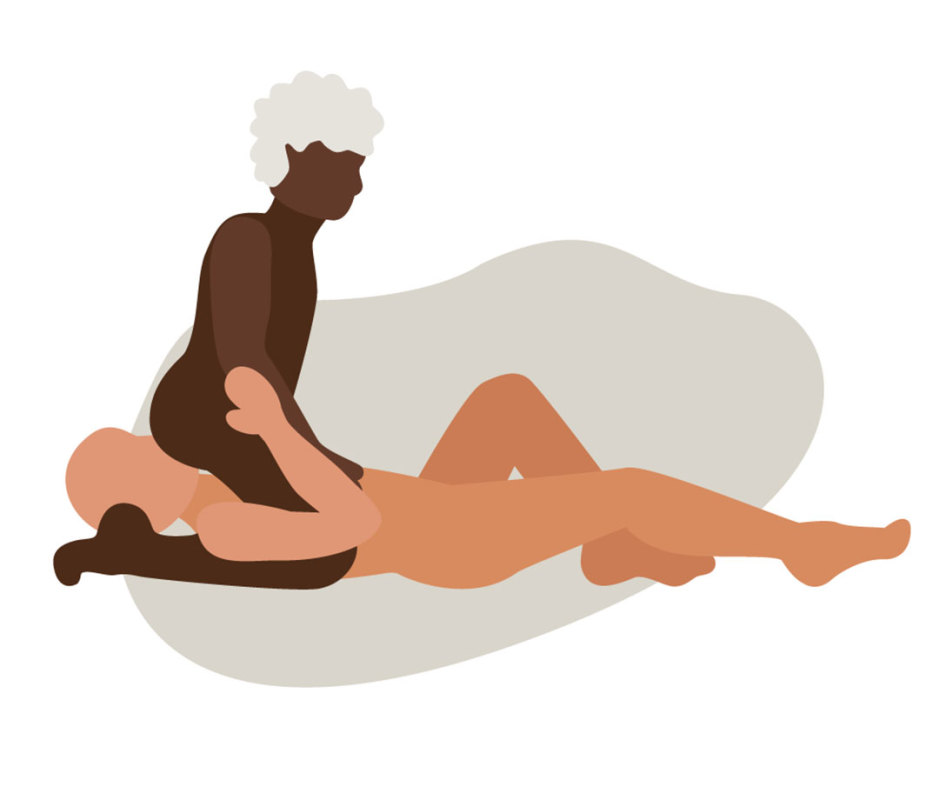
Katie Buckleitner
How to Do It
This reverse face sitting position flips the script and puts the emphasis on analingus. The receiving partner hovers their body over the giver’s mouth, taking care not to put too much body weight on their face. The receiver can use their legs to brace their weight and place their hands on their partner’s chest for balance, explains Halinowska.
Why It Works
This is a playful take on oral sex that also hedges into dominance and submission, as the receiving partner has the control.
| Pros | Cons |
|---|---|
|
Concentrated oral stimulation for receiver |
Might get uncomfortable for the giver’s neck |
Pro Tip
Use a wedge like Liberator Flip Ramp under the giver’s head for greater neck support.
15. Cowboy
Katie Buckleitner 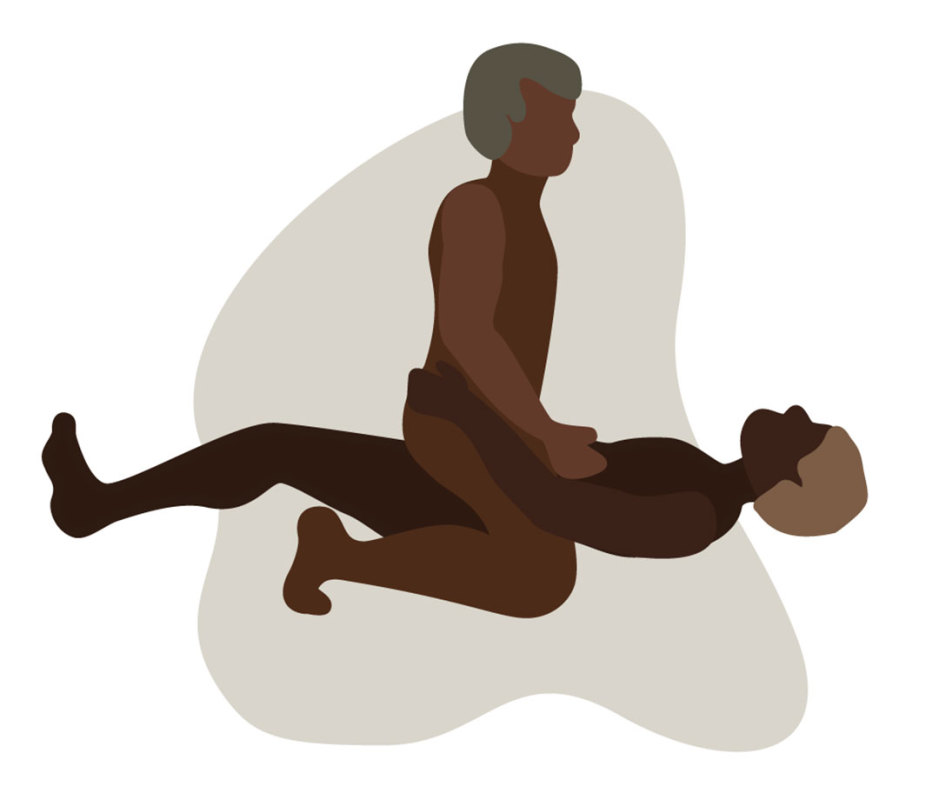
How to Do It
The receiver lies down on their back, and the receiver, facing him, eases down on the penetrator’s penis and bucks at the rate that feels good to him. “This position is great for receivers who want more control over the experience,” advises Deerhart.
Why It Works
“The receiver gets to decide how deep, fast, and intense the thrusting goes,” says Deerhart. “So they’re more likely to open up and freely enjoy being penetrated.”
| Pros | Cons |
|---|---|
|
The receiver can decide duration and intensity. |
This position can sometimes cause a penetrator to lose their hard-on since the flow of gravity naturally pulls blood downward in the erection. |
|
Some guys who penetrate in this position may feel too restricted, since the receiver is sitting on top of their body and taking charge. |
Meet the Experts
- Finn Deerhart, AASECT-certified sexuality counselor
- Dr. Rossana Sida, licensed marriage and family therapist and AASECT-certified sex therapist in Los Angeles, CA
- Kasia Halinowska, Bedbible.com sex educator
- Searah Deysach, sex educator and owner of Early to Bed
- Goody Howard, sex educator
Related: 10 Best Sex Swings of 2024: Why You Should Make a Push for One
-

 African History5 years ago
African History5 years agoA Closer Look: Afro-Mexicans 🇲🇽
-

 African History8 months ago
African History8 months agoBlack History Facts I had to Learn on My Own pt.6 📜
-

 African History5 years ago
African History5 years agoA Closer Look: Afro-Mexicans 🇲🇽
-

 African History1 year ago
African History1 year agoMajor African Tribes taken away during the Atlantic Slave Trade🌍 #slavetrade #africanamericanhistory
-

 African History1 year ago
African History1 year agoCameroon 🇨🇲 World Cup History (1962-2022) #football #realmadrid #shorts
-

 African History1 year ago
African History1 year agoWhat did Columbus Find in 1493? 🤯🔥🔥 #history #civilization #mesoamerica #africa #kemet
-

 African History7 months ago
African History7 months agoBlack History Inventors: Mary Kenner 🩸
-

 African History1 year ago
African History1 year agoOrigin Of ‘Cameroon’ 🇨🇲😳#africa




































